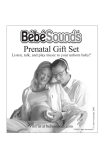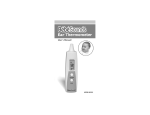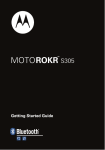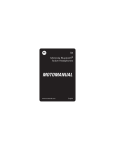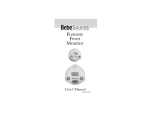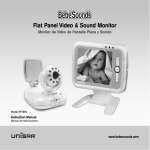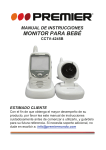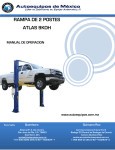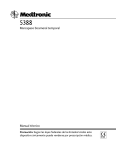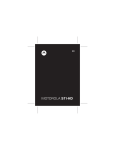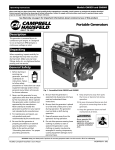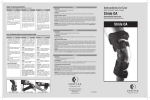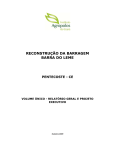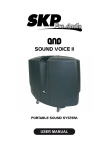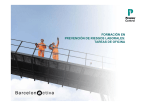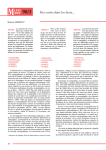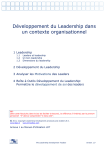Download Untitled - Startechtel.com
Transcript
Please Read The Following To Enjoy Our Product! • Please have patience. This product requires a little time but the results are wonderful. • What you will hear through the BébéSounds Monitor will be the NATURAL sounds of your baby . Your doctor uses Doppler ultrasound equipment that produces artificial noise. Our BébéSounds Fetal Monitor amplifies the actual and natural sounds of your baby. • • You might not hear sounds immediately so don’t be disappointed. You must have patience when trying to hear your baby’s sounds. The more you use the BébéSounds Monitor, the better you will become at finding the sounds. The baby’s position will also greatly affect your success. The best position is with his/her back to your belly button. Your success will also depend on how relaxed you are. You may have to try several times before you will hear your baby’s sounds, particularly the heartbeat, which may be heard as early as the fifth month. Other sounds are heard earlier. • Your baby’s heartbeat does not sound like your own. A fetal heart beats from 120-180 times per minute. It will sound like a soft, fast beating drum, or a galloping horse. Use a good battery. An old one will interfere with your BébéSounds Fetal Monitor. We recommend a new 9-volt alkaline battery. • • The best time to listen is 3-4 hours after eating and when you are relaxed. • The Monitor must be used in a very quiet room. • The Monitor must be placed on bare skin. Turn the Monitor on, place the listening cone against your bare stomach (start two inches below and several inches to the right of your belly button), and press the activation button to listen. Move the Monitor an inch at a time but be sure not to press the activation button as you move it. • Placing the volume control at a low to moderate level will produce the best results and avoid static. 2 You will also hear kicks, hiccups, and nutrients passing through the placenta. Kicks sound like uneven thumps, hiccups like two rapid drumbeats, and the nutrients like a whooshing sound. The Prenatal Heart Listener® is a personal care product and cannot be returned to the retailer. All Exchange And Refund Requests Should Be Directed To Our Help Desk If you are having difficulty, have questions, or need assistance, call our Help Desk toll free at 1-888-232-6476 Mon-Fri from 9:00AM-5:00PM EST. Please Read On 3 TABLE OF CONTENTS SECTION I. Listening to your unborn baby PAGE SECTION I. Listening to your unborn baby 1. Introduction 2. Your baby’s sounds 3. Recording your baby’s sounds 4. Instructions 5. Troubleshooting 6. Diagrams 5 5-7 7-8 8-9 9 10-11 SECTION II. Talking and playing music to your unborn baby 1. Introduction 12-13 2. How your baby develops 13-15 3. Research findings 15-16 4. Instructions for playing music 16-17 5. Instructions for talking and singing 18 6. Frequently asked questions 18-19 7. Endnotes 19 8. Diagrams 20-22 9. Music schedule 23 Record and Email your baby's sounds: 24-25 Warranty and Disclaimer: 26-27 Other products by BébéSounds®: 28-29 SECTION III. En Espagnol: 30-55 4 INTRODUCTION Please read the following material carefully to maximize your enjoyment of your BébéSounds® Prenatal Heart Listener®. It is important to understand that many factors affect what you will hear with your Fetal Monitor. The position of your baby, the baby’s weight, your weight, how far into your pregnancy you are, and where you place the Monitor all help to determine what you will hear. For example, when listening for the fetal heartbeat, the sound will be loudest in your third trimester and if your baby is positioned with her back to your belly button. Your baby may naturally shift her position, thereby creating the situation where you will hear the baby one moment but not the next. However, once you’ve passed your second trimester, your baby will be growing very rapidly and you will hear the heartbeat and all other sounds on a much more regular basis. Don’t worry! It is quite normal that there will be times you will not be able to hear your baby’s sounds due to her position or stage of development. This is especially true of the heartbeat, which is highly dependent on your IDENTIFYING THE FETAL SOUNDS YOU WILL HEAR You will hear the heartbeat, kicks, hiccups, and nutrients passing through the placenta. Each one is distinctive and being able to identify them will significantly enhance your experience. 5 We think the best way to describe each sound is as follows: Heartbeat: A rapidly galloping horse Kicks: A soft thud Hiccups: Two rapid intermittent thumps Nutrients: A whooshing sound A fetal heart beats from 120-180 times a minute while the heart of a pregnant woman beats much slower. Knowing this should help prevent you from confusing your own heartbeat with your baby’s. WHEN YOU WILL HEAR THESE SOUNDS The heartbeat may be heard as early as your fifth month. You will need to listen very carefully for your baby’s heartbeat at this point, as it may be difficult to hear it over the other sounds of your body as well as your own heartbeat. While the Prenatal Heart Listener® is designed to tune out these sounds, they can still get in the way. That is why the best time to listen is 3-4 hours after a meal and when you are relaxed and have a slower heartbeat. You may be able to hear your baby’s kicks and hiccups in the middle of your second trimester, and you will hear the passing of nutrients even earlier. Remember, as your baby grows and gets stronger, so does her heartbeat and her ability to kick harder, so don’t be discouraged if you don’t hear them right away. NATURAL SOUNDS vs. ELECTRONIC NOISE CREATED BY DOPPLER EQUIPMENT You will notice that the sounds you hear through the Fetal Monitor are different from those you have heard at your doctor’s office. This is because your doctor probably uses Doppler ultrasound equipment that creates noise 6 based on movement while the Prenatal Heart Listener® amplifies the natural sounds of your baby by using the absolutely safe and non-invasive Bell stethoscope method of amplification. Your baby’s heartbeat will sound like a rapidly galloping horse through the monitor while it will sound more like a gushing noise with the Doppler equipment. Please keep in mind that it will take a little practice to pick up this faint sound so listen very carefully. RECORD YOUR BABY’S SOUNDS AND YOUR OWN HEARTBEAT With our recording cable and your own tape recorder you can record your baby’s sounds to cherish forever. We also encourage you to record your own heartbeat prior to your baby being born. The sound of your heartbeat will have a calming and soothing effect on your newborn baby. The Prenatal Gift Set is a Personal Care Product and cannot be returned to the retailer. All exchange and refund requests should be directed to our Help Desk. If you are having difficulty, have questions, or need assistance, call our Help Desk toll free at 1-888-232-6476 Mon-Fri from 9:00AM-5:00PM EST Please read on 7 INSTRUCTIONS For Listening (Please refer to diagrams on P. 10-11): 1. Make sure the foam cover is in place on the listening cone. 2. Remove battery compartment door and install a new 9-volt alkaline battery (not included), keeping the ribbon under the battery and exposed for easy removal. Press battery forward and down. Be sure to use a new battery as an old one will severely interfere with the performance of your Monitor. 3. Insert the headphone plug into either jack on the Monitor. 4. Turn on the Prenatal Heart Listener ® using the ON/OFF volume control switch. The red LED will light to indicate the unit is in the ON position. 5. Use the Monitor on bare skin in a quiet room. 6. Hold the cone to your stomach or lower back (near your kidneys) and press and hold down the activation button. Adjust the volume to optimize the listening level and amplification. Start with a low to moderate setting to avoid static. 7. If you do not hear the heartbeat, release the activation button and gently move the Monitor one inch at a time to different places until you find the best position for listening to your baby’s sounds. Start two inches below and a little to the right of your belly button. Always release the activation button when you are moving the Monitor across your stomach or back. For Recording: 1. To record these sounds plug the L-shaped end of the recording cable into either jack of the Monitor and the straight end into the line input of your tape recorder. (Some portable recorders do not provide this input.) 2. Position the Monitor on your bare skin so you can hear the sounds you wish to record. 3. Adjust the recording level on your tape recorder if necessary. 4. Hold the Monitor very still and begin recording. 8 5. When you record your own heartbeat to play to your newborn, reduce the volume as your heartbeat is much louder than you unborn baby’s. We suggest making a 30-minute recording of your heartbeat. TROUBLESHOOTING If your unit is not working properly, please check the following: 1. Activation button is not held down during listening. 2. Volume control is too low. 3. Battery and/or headphone connection is not complete. 4. Foreign matter is in the listening cone. 5. Weak battery (ON/OFF LED signal will be dim). 6. Feedback/squealing noises – turn down the volume and/or move the headphones further away from the Monitor. Press activation button only when the Monitor is against your body. 7. Foam cover is not in place on the listening cone. The Prenatal Gift Set is a Personal Care Product and cannot be returned to the retailer. All exchange and refund requests should be directed to our Help Desk. If you are having difficulty, have questions, or need assistance, call our Help Desk toll free at 1-888-232-6476 Mon-Fri from 9:00AM-5:00PM EST Please read on 9 KIT COMPONENTS TOP VIEW AND BOTTOM VIEW GRAPHIC Headphone YOU MUST PRESS AND HOLD DOWN THE ACTIVATION BUTTON TO LISTEN ON/OFF Volume Control ON/OFF LED Signal Prenatal Heart Listener TM FIG. 1 BébéSounds® Fetal Monitor Activation Button Pre na FIG. 2 tal He art Battery Compartment FIG. 6 Lis ten er TM LED Power Indicator FRONT VIEW ON/OFF Volume Control Speaker/Headphone Jack FIG. 3 Instruction Manual Foam Cover Recording Cable Listening Cone Foam Cover FIG. 7 FIG. 4 FIG. 5 10 11 SECTION II. Talking and playing music to your baby INTRODUCTION Research Into the benefits of stimulating your unborn baby has been done worldwide and it is now believed that your baby can learn while still in your womb. Therefore, while most of the attention in the past has focused on the positive results of infant stimulation, it is very important not to overlook the benefits of prenatal stimulation. Studies have shown that the prenatally stimulated baby tends to display faster visual, linguistic, and motor development than the baby who was not stimulated. Research has also shown that the brain of the prenatally stimulated baby tends to be more developed, thereby providing a better foundation for the child to have a higher IQ and intelligence level. Prenatal stimulation can come from playing classical music (considered to be one of the best sources of stimulation), talking or singing to your baby, and even rubbing your stomach. “The most effective way to stimulate your baby and enhance her brain development while still in the womb is through sound.”1 Dr. Norman A. Ravski, Assistant Clinical Professor, Department of Obstetrics and Gynecology at Yale University School of Medicine, and Attending Physician at Yale New Haven Hospital has endorsed playing classical music to your baby. In his endorsement Dr. Ravski states, “In-utero fetal acoustic stimulation has been shown to improve pregnancy outcomes as well as benefit the growing fetus.” The BébéSounds® Prenatal Gift Set enables you to direct our specially selected classical music through your womb to your baby with our Fetal Speakers. 12 It is also believed that your newborn baby will recognize the voices of her parents immediately after birth if they are heard while in the womb. In addition to stimulating your baby, talking to her will help your baby’s father bond with her. Talk and sing to your unborn baby by using the BébéSounds® Fetal Speakers and Microphone, which will amplify your voices so they will be heard over the other noises inside the womb. When speaking to your baby, keep in mind that the first step of your baby’s development of language skills is the recognition of intonations so it is important for both parents to speak to their child. Although the mother’s voice tends to be more melodic and is constantly heard, the father’s voice is louder and deeper and penetrates the womb more easily. It is always a good idea to keep your doctor informed of what you are doing during your pregnancy. Therefore, we suggest that you inform your doctor that you will be stimulating your unborn baby with the BébéSounds® Prenatal Gift Set. HOW YOUR UNBORN BABY DEVELOPS First Trimester – The embryo begins to develop; head and limbs start to form; the head, body, and limbs begin to move (you won’t feel this movement yet); the nervous system that deals with equilibrium and spatial relations begins to develop; and the heart begins to beat more strongly. Second Trimester – The head develops more actively than the rest of the body; the eyes respond to light; key organs mature; the fetus reacts to music and loud noises; arms and legs are moving strongly enough so you can feel them; the fetus can hear and the ability to learn significantly increases; signs of memory and the ability to respond to various stimuli are apparent; and music has a calming effect while harsh sounds have an agitating effect. 13 Third Trimester – The nervous system has matured and becomes fully formed; the brain enters a rapid growth phase; movements are more coordinated and muscles are stronger; the fetus moves to the rhythm of music; sight has developed and response to light is evident; movement is less frequent but stronger toward the end of the ninth month; and growth and development continue until birth. HOW YOUR UNBORN BABY’S BRAIN DEVELOPS Your baby’s brain begins developing almost immediately and by the fifth month the number of brain cells your baby will have for the rest of her life is determined. From this point forward her brain develops by increasing the size and complexity of the cells already created. Around the eighth month your unborn baby’s brain changes significantly. At this time it doubles in weight and the connections between the brain cells, known as synapses, become even more complex. The following is the structure of a brain cell: 1. Dendrites – receive messages from the body 2. Cell body – decides whether to send the message received from the dendrites or to store it 3. Axon – transmits messages received from the cell body As the cells get larger, the axons grow longer and the dendrites become an increasingly complex system of multiple connections like branches of a tree. The more stimulation the cells receive, the more complex these dendrites become, resulting in a more developed brain. RESEARCH FINDINGS It is now known that stimulation of the senses affects the growth of the brain cells and if a fetus has little stimulation in the womb, fewer connections are made. Specialists in fetal and infant brain development have agreed that stimulating your unborn baby’s senses can affect the development of the connections between the brain cells. In fact, the lack of these connections can actually cause cells to die, especially in the eighth month of pregnancy. 2 By the end of the fifth month your baby can hear and begins to learn, and you can tell when she is reacting to external stimulation. In one case, pregnant mothers actually had to leave a concert of classical music before it was over because their babies were kicking so hard in time to the music that they couldn’t tolerate it. 3 In another case, mothers were asked to play their favorite classical music to their unborn baby for ten minutes a day at a volume that was just a little louder than a normal speaking voice. It was discovered that the babies recognized the change in their environments immediately as was evidenced by their heart rates increasing noticeably. What is also interesting is that the unborn baby does not respond in this way to many single notes even if they are played very loud and very close to her. 4 Yet another study showed that unborn babies who had classical music played to them from the middle of the fifth month until they were born, for 10 minutes, twice a day, developed more quickly, began to talk up to six months earlier, and had greater intellectual development than those babies who had not had classical music played to them inside the womb.5 The number of brain cells your baby is born with helps determine her potential, but it is also the number of connections between these cells that determines her final intelligence. Helping to increase the number of connections and the complexity of the brain cells with stimulation increases the probability of your baby having a higher intelligence level and IQ. 14 15 Some women worry that if they improve the brain’s development the baby’s head will be larger, thereby causing an increase in the risk of delivery problems. In fact, there is reason to believe the opposite is true. Prenatal sound stimulation has led to shorter and less painful labor periods, a lower number of Cesarean section deliveries, and a greater number of non-traumatic births. 6 In addition, a baby who experiences prenatal stimulation tends to: • Be calmer and more alert • Be happier and cry less • Have a longer attention span • Be stronger and have better coordination • Lift his or her head up earlier and stand earlier • Walk earlier • Talk earlier • Have more self-confidence7 INSTRUCTIONS (You will need your own CD/Cassette player) Remember, by the end of the fifth month your unborn baby begins to hear, and by the sixth month her ability to learn increases significantly. It is now time to start stimulating your baby. Keep in mind that your baby is most alert during the evening hours so you may want to play music or talk to her a few more times. But remember, she also has to rest. The Prenatal Gift Set is a Personal Care Product and cannot be returned to the retailer. All exchange and refund requests should be directed to our Help Desk. If you are having difficulty, have questions, or need assistance, call our Help Desk toll free at 1-888-232-6476 Mon-Fri from 9:00AM-5:000PM EST 16 To Play Music to Your Unborn Baby (Please refer to diagrams on P. 20-22) The best time to play the music is once in the morning and once in the evening, for a period of 5-10 minutes, around the same time each day. Be careful not to play the music too long or too frequently, as your unborn baby also needs to rest. However, you will probably find that your baby will be very active and obviously awake during the evening. Do not play the same music over and over again. It is believed that if your baby hears the same thing repeatedly, she will eventually ignore it. However, periodic repetition of the same music is advisable. In some cases when the music was played after the baby was born, the newborn seemed to recognize the melody. Therefore, we suggest playing different music during each session in a single day, and replaying it two or three days later. We also suggest that you keep a schedule for the music you have played showing the date, music played, and times it was played. (We’ve provided you with a starter schedule on P.23 in this booklet.) Now, simply follow these easy steps. (See diagrams P.20-22) 1. Connect the cable from the Fetal Speakers to your own CD/Cassette player. Use the adapter if you want to listen to the music at the same time. 2. Insert the enclosed CD or cassette of classical music. 3. Position the speakers against your belly. You will want to adjust the position of the speakers depending on what month of your pregnancy you are in. You should be able to tell where your baby’s head is by where you feel her kicking most frequently. You may tuck the speakers into your clothing or use the BébéSounds® maternity belt to hold them in place. 4. Play the music for approximately 10 minutes at a time and alternate the selections you play. Use the schedule included in this booklet as a record of what selections you have played and how frequently you played them. 17 5. Play the music just a little louder than you would normally play it for yourself. If it is much too loud for you it will be too loud for your baby. The maternity belt will provide you with support and additional comfort while you are doing something special for your baby. You may wear it when you are not playing music to your baby as well. Please care for it by hand washing it in cold water using a mild soap. To Talk, Sing, and Read to Your Unborn Baby Use the Fetal Microphone and Speakers to penetrate the sounds of your womb so your baby will hear you. Be careful to speak in a normal voice. The microphone will amplify your voices so you don’t have to speak too loudly as this will disturb your baby. You may also want to gently stroke your stomach while you are speaking. Alternate your voice with the baby’s father’s voice – 5 minutes of yours and then 5 minutes of his. Speak in loving tones and repeat what you say 3-4 times. Repeat this a few times each day. Also read your baby a story. Choose one that you will read after she is born. FREQUENTLY ASKED QUESTIONS What type of music should I play? The universal opinion seems to be that classical music is the best. That is why we have enclosed a 60-minute CD and cassette of specially selected music by Mozart. Are you sure I won’t be disturbing my baby when I play the music or speak to her? Yes. What you will be doing is stimulating your baby and helping her brain develop. However, if you play the music or speak too long or too frequently, you will disturb your baby. Please remember your baby must have time to rest as well as develop. How soon can I start talking and playing music to my baby? By the end of your fifth month your baby’s senses are developed enough so she can hear. Continue stimulating your baby from the end of your fifth month until she is born. ENDNOTES 1. Jay Gordon, M.D. and Brenda Adderly, M.H.A., Brighter Baby,(Washington, D.C.: Lifeline Press, 1999) 79 2. Dr. Susan Ludington-Hoe with Susan K. Golant, How To Have A Smarter Baby, (New York: Bantam Books, 1987), 39 3. Dr. Susan Ludington-Hoe with Susan K. Golant, How To Have A Smarter Baby, (New York: Bantam Books, 1987), 18 4. Dr. Susan Ludington-Hoe with Susan K. Golant, How To Have A Smarter Baby, (New York: Bantam Books, 1987), 18 5. Dr. Sarah Brewer, Super Baby, (London: Thorsons, 1998), 70 6. Dr. Sarah Brewer, Super Baby, (London: Thorsons, 1998), 97-98 7. Dr. Sarah Brewer, Super Baby, (London: Thorsons, 1998), 229 How loud should I play the music or speak? Because the sound must pass through your womb and be heard over the natural sounds of your body, play the music a little louder than you would for yourself and speak in a normal voice as the microphone will amplify it. 18 19 COMPONENTS FOR TALKING AND PLAYING MUSIC DIAGRAM FOR PLAYING MUSIC TO YOUR UNBORN BABY Your own headphones Fetal Speakers Adapter Fetal Speakers Maternity Belt 60-minute Mozart cassette and instruction manual Adapter Maternity Belt 60-minute Mozart CD Your own cassette or CD player Fetal Microphone 20 21 DIAGRAM FOR TALKING TO YOUR UNBORN BABY SCHEDULE OF MUSIC PLAYED DATE TIME PLAYED Fetal Microphone Fetal Speakers Maternity Belt 22 23 MUSIC PLAYED • Your computer is now recording. Adjust the volume so the recording level indicator in the device control box bounces within in the recording range. If the recording level indicator is a solid color, then the volume in the Recording Control box needs to be reduced. If this does not bring the recording level down, check your sound card manual and reduce the recording level through your sound card software. • When your 3 minute recording session is finished, name it and save it in a familiar directory. You must save it as a .wav file. Record and email your baby's heartbeat with your computer 1. Download and install the GoldWave V4.25 software (free) from http://www.goldwave.com 2. Set your device input and volume controls as follows: • Open GoldWave • Select Tools – Volume control – Options – Properties • Under*Adjust volume for*select*Recording* • Under*Show the following controls:*check*Mic* • Click OK. • When the Recording Control box comes up make sure the select box at the bottom is checked. • Minimize or move the Recording Control box off to the side. 3. Create a new recording file using the following steps: • From the GoldWave main menu click File – New • Under *Channels*select *Mono* • Under*Sampling rate (Hz)* select*22050* • Under*Length (MM:SS.TTT)*select*3:00.000* • Select OK – GoldWave will create your new sound recording file. 4. You are now ready to record a sound file using your BébéSounds® Prenatal Heart Listener®. Take the following steps: • Setup you BébéSounds® Prenatal Heart Listener® with the battery and headphones as you would for normal listening. • Plug the L shaped end of the recording cable in to the available output jack of the BébéSounds® Prenatal Heart Listener® monitor. • Plug the straight end of the recording cable in the microphone jack of your computer sound card. • If the Device Control box is not visible on your screen, make it visible by clicking – Tools – Device Controls from the GoldWave main menu. • Find your baby’s heartbeat and prepare to record. • To begin your 3 minute recording session, hold down the CTL key and click the red record button in the Device Control box. 24 5. Your .wav file of your baby’s sounds is now complete. Unfortunately your .wav file will be over 7 megabytes in size which is much to large to email to family or friends. It is for this reason we will now convert your .wav file into a .rm file using Real Producer. • Go to http://www.realnetworks.com/products/producer/basic.html and download RealSystem Producer Basic (free). • Open RealProducer and take the following steps to convert your .wav file. • Press File – Recording Wizards – Record from file. • Press the browse button then locate and open your .wav file. • Fill in your RealMedia Clip information. It is all right to keep your file name the same since the extension will be different. Press next. • Use*Multi-rate SureStream for RealServer G2*. Press next. • Check your optimization rate. Press next. • Under Audio Format check Voice Only. Press next. • Confirm your new .rm file name. Press next. Press Finish. • The wizard has now filled in the main menu. Press Start in the Recording Controls box to convert you .wav file to an .rm file. • Your 7 megabyte .wav file has now been converted to a 1 megabyte .rm file. 6. To play your .rm file you must have RealPlayer Basic. • Go to http://www.real.com/help/index.html • Download and install RealPlayer Basic (free). • To play your .rm file just open RealPlayer, select your file. Once the file is open it will begin to play through your PC speakers. • Your .rm file can now be emailed as an attachment to friends and family. 25 USTED TIENE QUE LEER LO SIGUIENTE PARA DISFRUTAR ESTE PRODUCTO • Colocando el volumen entre mínimo e intermedio producirá los mejores resultados y evitara estática. • Por favor tenga paciencia. Este producto requiere un poco de tiempo para obtener maravillosos resultados. • Es posible no escuchar sonido inmediatamente, por lo cual no se Usted debe tener paciencia cuando trata escuchar los sonidos de su bebe. Con el uso frecuente del BébéSounds® Monitor, usted adquirirá mas experiencia en la localización del sonido de su bebe. La posición de su bebe también afectara su éxito en la escucha de sonidos. La mejor posición es cuando su bebe se encuentra de espaldas y contra su ombligo. Su éxito dependerá de cuan relajada usted se encuentre. Es posible que usted deba intentar varias veces antes de escuchar el sonido de su bebe, particularmente el latido de su corazón, el cual se escucha mejor a fines del segundo trimestre. Otros sonidos son escuchados con anterioridad. • Lo que usted escuchara a través del BébéSounds® Monitor será el sonido natural de su bebe. Su doctor utiliza un equipo de ultrasonido Doppler el cual produce un sonido artificial. El Monitor amplifica el sonido • Utilice una batería nueva. Una batería usada interferirá con su Monitor. Recomendamos usar una batería alcalina nueva de 9-volteos. • La mejor hora para oírlo es 3-4 horas después de comer y cuando usted se encuentre relajada. • Usted debe usar el Monitor en una habitación sin ruidos. • Usted debe colocar el Monitor directamente sobre su piel. Encienda el Monitor, coloque el cono para escuchar en contacto con su abdomen (comience dos pulgadas (cinco centímetros) abajo y unas pulgadas (o varios centímetros) a la derecha de su ombligo), y presione el botón de encendido para escuchar. Mueva el Monitor una pulgada (2.5 centímetros ) a la vez pero asegúrese de no presionar el botón al • Colocando el volumen entre mínimo e intermedio producirá los mejores resultados y evitara estática. 26 • Los sonidos del corazón de su bebe no son como el de usted. El sonido de un feto late entre 120-180 veces por minuto. Sonara como un latido suave y rápido o como un galope de un caballo. • Usted también escuchara patadas, hipos y nutrientes pasar a través de Las patadas se escucharan como golpes inconstantes, los hipos como dos rápidos golpes de batería, y los nutrientes como una explosión AHORA POR FAVOR LEA EL MANUAL DE INSTRUCCIONES 27 INTRODUCCION BébéSounds® amplifica los maravillosos sonidos que el bebé hace dentro del vientre de la madre. A partir de ahora, usted podrá escuchar a su bebé tan pronto como éste empiece a moverse. Desde el séptimo mes podrá oír cuando su bebé tenga hipo, patée y hasta los suaves latidos de su corazoncito. Esta experiencia le hará sentir muy cercano a su bebé y quererlo aún más. BébéSounds® fué inventado por una enfermera especializada en recién nacidos, por lo que puede usarse con total confianza. BébéSounds® le permitirá escuchar los sonidos de esa nueva vida por venir y compartir su alegría con sus familiares y amistades más cercanas. En la intimidad de su hogar, usted podrá grabar para siempre los primeros sonidos de su bebé usando su propia grabadora y el cable de grabacion que se incluye con el BébéSounds®. CONTENIDO DEL PAQUETE Audífonos FIG. 1 Monitor fetal s® Este paquete incluye el Monitor Fetal BébéSounds®, audífonos, un folleto de instrucciones, y un cable de grabación. Importante! No se preocupe si al comienzo no logra escuchar a su bebé. Puede ser que el bebé sea todavía muy pequeño o que a veces no esté en la mejor posición para escucharlo. Recuerde esto especialmente cuando quiera oír los latidos del corazón, ya que estos sonidos dependen mucho de la posición del bebé y son muy Botón de activación Pre na tal He art Lis ten er Luz indicadora de energía TM FIG. 3 FIG. 2 Manual de instrucciones Le sugerimos señora mamá, utilizar el BébéSounds® para grabar los latidos de su propio corazón antes de que nazca su bebé. Así, el recién nacido podrá seguir escuchando el corazón de su mamá, sonido que le ayudará a calmarse y descansar mejor. Cubierta de espuma Cable de grabación FIG. 4 28 FIG. 5 29 INSTRUCCIONES PARA EL USO DEL BébéSounds® 1. Asegúrese que la Cubierta de espuma esté colocada sobre el Cono de detección. 2. Abra el compartimiento para pilas e instale una de 9 voltios (no está incluída). Se recomiendan pilas alcalinas. 3. Inserte la clavija de los audífonos en la entrada del BébéSounds®. 4. Encienda el BébéSounds® usando el control de volumen ON/OFF. 5. La luz indicadora de energía se prenderá mostrando que la unidad está encendida. 6. BébéSounds® debe ser usado directamente sobre la piel y preferentemente en una habitación silenciosa. 7. Acerque el detector cónico a su vientre o espalda directamente sobre la piel. OPRIMA SIN SOLTAR EL BOTON DE ACTIVACION para escuchar los maravillosos sonidos de su bebé. Ajuste el volumen segun sea necesario. 8. Suelte el botón de activación y mueva el BébéSounds® una pulgada (2-3cm) cada vez hasta encontrar la mejor ubicación para escuchar los sonidos del bebé. Algunas sugerencias para el uso del BébéSounds® • El BébéSounds® tiene un gran poder de amplificación de sonidos, necesario para poder captar los suaves sonidos producidos por su bebé. Para proteger sus oídos y prevenir la retroalimentación acústica (sonido agudo y estridente), NO oprima el botón de activación hasta que el BébéSounds® esté presionado • Aleje los audífonos del BébéSounds® si es que ocurre la retroalimentación acústica (sonido agudo y estridente). • Ajuste el volumen poco a poco para mejores resultados. Su cuerpo y su bebé producen muchos sonidos diferentes, que son amplificados si usted aumenta el volumen. Es por esto que un nivel moderado de volumen produce normalmente los mejores resultados. • Los latidos del corazón de su bebé son sonidos muy suaves, por lo que son muy difíciles de captar hasta el séptimo mes del embarazo. Usted requerirá paciencia y mucha atención para ubicar la posición más adecuada para escuchar los latidos. Debido a la posición y movimientos de su bebé, es completamente normal escuchar los latidos unos días sí y otros no. 30 COMO GRABAR USANDO EL BébéSounds® 2. 3. 4. 5. Inserte el extremo en forma de "L" del cable de grabación (Fig.4) en la entrada del BébéSounds® y el extremo recto en la entrada marcada "line input" de su grabadora. (Algunas grabadoras portátiles no tienen esta entrada.) Coloque el BébéSounds® sobre su cuerpo de modo que pueda escuchar los sonidos que desea grabar. Si es necesario, ajuste el volumen de grabación en su grabadora. No mueva el BébéSounds®, y empiece a grabar. El sonido de su corazón tiene un gran efecto calmante sobre el recién nacido. Por esto, usted podría grabar sus propios latidos durante unos 20 minutos, para que pueda hacérselos escuchar a su recién nacido. (Reduzca el volumen en el BébéSounds® a la hora de grabar sus propios latidos, ya que éstos son mucho más fuertes que los RECHAZO DE RESPONSABILIDAD BébéSounds® NO ES UN ARTEFACTO MEDICO BébéSounds® no es un artefacto médico y no debe ser usado de manera alguna para propósitos de diagnóstico u otros fines médicos. Cualquier pregunta sobre su embarazo debe ser dirigida BébéSounds® no se propone sustituir el diagnóstico de su médico. Como tampoco, BébéSounds® no debe utilizarse para sustituir el cuidado del embarazo que sólo su médico puede proporcionarle. Le recomendamos que busque el cuidado profesional que un embarazo requiere. BébéSounds® debe ser usado únicamente de acuerdo a las instrucciones aquí proporcionadas. Los fabricantes y distribuidores del ® no se responsabilizan por el uso inadecuado del BébéSounds ® . El fabricante rechaza expresamente responsabilidad por cualquier daño imprevisto, consecuente, o especial de cualquier naturaleza. 31 VISTA SUPERIOR SOLUCION DE PROBLEMAS COMUNES Verifique lo siguiente si la unidad no funciona: Para escuchar, usted debe oprimir sin soltar el Botón de ACTIVACIÓN. Control de volumen ON/OFF Luz indicadora de energía Prenatal Heart Listener TM Compartimiento para pilas El botón de activación no se mantiene oprimido para escuchar. El control de volumen está muy bajo. Las conexiones de la batería y/o de los audífonos no están bien enchufadas. La presencia de cuerpos extraños en el cono de detección. La batería está descargada. (La Luz indicadora de energía está apagada 6. Retroalimentación acústica (sonido agudo y estridente) - reduzca el volumen y/o aleje el audífono del BébéSounds®. Oprima el botón de activación sólo cuando el BébéSounds® esté presionado contra su cuerpo. 7. La cubierta de espuma no está colocada sobre el cono de detección. GARANTIA DEL PRODUCTO GARANTIA LIMITADA DEL PRODUCTO BébéSounds® , distribuído por UNISAR® está garantizado contra defectos por un período de 90 dias después de la fecha original de compra. FIG. 6 VISTA FRONTAL 1. 2. 3. 4. 5. Control de volumen ON/OFF Entrada para los audífonos PROCEDIMIENTO PARA UN PRODUCTO BAJO GARANTÍA En caso de que la unidad requiera servicio debido a defectos o malfuncionamiento durante el período de garantía, UNISAR® reemplazará o reparará la unidad. La reparación o reemplazo de la unidad defectuosa se hará libre de gastos, con excepción de un pago de US $7.00 para gastos de embalaje, manejo, seguro y estampillas para el envío postal. La reparación o reemplazo de la unidad defectuosa está sujeta a la verificación del malfuncionamiento o defecto cuando sea recibida en el Centro de Servicio UNISAR® indicado más Cono de detección Cubierta de espuma FIG. 7 32 33 Nota: Antes de devolver su BébéSounds® reemplace la pila por una nueva y pruebe otra vez. Pilas defectuosas o descargadas son la causa más común de problemas con este producto, y no están cubiertos bajo esta garantía limitada. Incluya prueba de la fecha de compra y un cheque o giro bancario por US $7.00 a nombre de UNISAR®. Envíe el paquete por correo con las estampillas necesarias a la dirección indicada abajo: Unisar Service Center 15 West 36th Street New York, NY 10018 USA. NOTA: El garantizador rechaza expresamente responsabilidad por cualquier daño imprevisto, consecuente, o especial de cualquier naturaleza. (Algunos estados no permiten la exclusión o limitación de daños imprevistos o consecuentes, de modo que la garantía arriba mencionada puede no ser aplicable a usted.) Esta garantía no cubre (1) Un defecto causado por reparación o modificación. (2) Un defecto causado por negligencia, accidente, o mal manejo del producto. (3) Un defecto causado por instalación incorrecta y/o pilas defectuosas. (4) Daño resultante de una Cualquier garantía implícita deberá tener una duración limitada a los términos de esta garantía. (Algunos estados no permiten limitaciones en la duración de una garantía implícita, por lo que la limitación mencionada arriba puede no ser aplicable a usted.) BébéSounds® está sujeto a patentes de diseño y utilitario en los Estados Unidos, y a documentos equivalentes en el extranjero. NOTA: Esta garantía es válida sólo para productos vendidos en los Estados Unidos. Si usted compró su producto fuera de los Estados Unidos, sírvase visitar al concesionario o distribuidor más cercano para obtener servicio. 34 INTRODUCCION Investigaciones realizadas acerca de los beneficios de estimular a los bebes antes de nacer a sido realizada mundialmente, y ahora hay pruebas de que los bebes pueden aprender mientras se encuentran adentro el útero. Por lo tanto, mientras que en el pasado la atención estaba concentrada en la estimulación infantil, es muy importante prestar atención a los beneficios de la estimulación prenatal. Estudios han mostrado que el bebe estimulado prenatalmente muestra un mas rápido desarrollo visual, lingüístico, y motriz que los bebes no estimulados. Adicionalmente, estudios han mostrado que el cerebro de un bebe estimulado prenatalmente tiene una tendencia a estar mas desarrollado, mostrando como resultado un mayor porcentaje de posibilidades de que el bebe tenga un mayor nivel intelectual e inteligencia. La estimulación puede provenir de: tocar cierta clase de música clásica (considerada una de las mejores fuentes de estimulación), hablar a su bebe, y también de frotar el estomago de la madre. “La mejor forma de estimular a su bebe y mejorar el desarrollo de su cerebro mientras esta dentro de útero de la madre con sonidos”.8 Es un hecho que el bebe recién nacido reconocerá las voces de sus padres inmediatamente solo si el los ha escuchado antes dentro del El BébéSounds® Prenatal Talk ,n Tunes® le permite tocar música clásica directamente a su bebe a través de Fetal Speakers (parlantes. Estos han sido aprobados por el Dr. Norman A. Ravski, Profesor de Asistencia Clinica, Departamento de Obstetricia y Ginecología de la Escuela de Medicina de la Universidad de Yale, y Doctor del Hospital Yale New Haven. 35 En su aprobación el Dr. Ravski declara que “Dentro del útero la estimulación acústica ha demostrado mejorar los resultados del embarazo como también los beneficios del crecimiento del feto... Creo que este producto va a mejorar tanto la comodidad de la mujer embarazada como la del feto creciendo dentro del útero.” El BébéSounds® Prenatal Talk ,n Tunes® le permite dirigir las vices directamente a su bebe, todavía dentro del útero de la madre, a través de nuestro Micrófono y Parlantes Fetales. El primer paso en el desarrollo lingüístico de su bebe es el reconocimiento de entonaciones por lo cual, es importante para ambos padres hablar a su bebe. Aunque la voz de la madre es por lo general mas melódica y es constantemente escuchada, la voz del padre es mas potente y profunda lo cual genera una mayor penetración en el útero. Es siempre una buena idea mantener informado a su medico de lo Ud. esta haciendo durante su embarazo. Por lo tanto, nuestra sugerencia es informar a su medico que Ud. va a estar usando el ® Prenatal Talk ,n Tunes®. 36 COMO SU BEBE NO NACIDO TODAVIA SE DESARROLLA Primer Trimestre - El embrión comienza a desarrollar su cabeza y miembros (Ud. no sentirá los movimientos), el sistema nervioso que se encarga del equilibrio y espacio comienza a desarrollarse, y el corazón comienza a latir mas fuertemente. Segundo Trimestre - La cabeza se desarrolla mas activamente que el resto del cuerpo; los ojos responden a la luz ; los órganos importantes se desarrollan; el feto reacciona a sonidos fuertes y a música; los brazos y piernas se mueven tan fuertemente que la madre puede sentirlos; el feto puede oír y la habilidad de aprendizaje se incrementa significativamente; la capacidad de memoria y la habilidad de responder a estímulos se hacen presentes; la música calma al feto, mientras que sonidos agresivos Tercer Trimestre - El sistema nervioso se ha desarrollado y se ha desarrollado completamente; los movimientos son mas coordinados y los músculos son más fuertes; el feto se mueve al ritmo de la música; vision se ha desarrollado y su respuesta es evidente; el movimiento es menos frecuente pero mas fuerte cerca del fin del noveno mes; y el crecimiento y el desarrollo del bebe continúan hasta el nacimiento. 37 COMO EL CEREBRO DE SU BEBE NO NACIDO TODAVIA Su bebe se desarrolla en diferentes etapas, pero el cerebro se desarrolla casi inmediatamente, y para el quinto mes, es determinado él numero de células que el cerebro de su bebe va a tener por el Desde ese momento en adelante, no produce mas células cerebrales, pero se desarrolla incrementando el tamaño y la complejidad de las células ya creadas. El numero de células cerebrales con que su bebe nace ayuda a determinar su potencial, pero es el numero de conexiones entre esas células, conocidas como sinapsis, el que determina su inteligencia final. Si se incrementa el numero de conexiones y la complejidad de las células cerebrales, el resultado final será una mayor probabilidad de que su bebe tenga una mayor inteligencia y coeficiente intelectual. El siguiente es el programa del desarrollo del cerebro. • Para el fin del quinto mes él numero de células cerebrales que su bebe tendrá estará determinado. • A partir del quinto mes en adelante, el cerebro crece y el tamaño y complejidad de células cerebrales crecen. • Alrededor del octavo mes el cerebro de su bebe no nacido todavía cambia significativamente. A este momento el cerebro duplica su peso y las conexiones (synapses) entre sus células son 38 RESULTADOS DE INVESTIGACIONES Es un hecho que la estimulación de los sentidos afecta el crecimiento de las células cerebrales, y si el feto tiene poca estimulación dentro del útero de la madre, pocas conexiones (synapses) serán hechas. Especialistas en desarrollo del cerebro de fetos e infantes afirman que la estimulación de loas sentidos de su bebe antes de nacer puede afectar el desarrollo de las conexiones entre las células cerebrales. Es mas, la ausencia de esas conexiones pueden causar la muerte de células, especialmente durante el octavo mes de embarazo. 2 Para el fin del quinto mes su bebe puede oír y empieza a aprender, y Ud. puede darse cuenta cuando el / ella reacciona a estímulos externos. En un caso, mujeres embarazadas tuvieron que abandonar un concierto de música clásica antes de su culminación, porque sus bebes estaban pateando tan fuertemente que no podían tolerar el En otras situaciones, varias madres experimentaron tocando su música clásica favorita por 10 minutos cada día un poco mas fuerte del volumen normal de la voz humana. Fue descubierto que los bebes reconocieron el cambio en su medio ambiente, debido a la aceleración de sus ritmos cardiacos. Lo más interesante es que los bebes todavía no nacidos no responden de esta manera a cualquier sinfonía, aun si esta es tocada muy fuerte y muy cerca del bebe. 4 Sin embargo, otro estudio mostró que los bebes todavía no nacidos que han sido expuestos a música clásica dos veces al día por 10 minutos, desde el quinto mes de embarazo hasta el nacimiento, se han desarrollado mas rápidamente, han empezado a caminar hasta 39 seis meses antes, y han tenido un mayor desarrollo intelectual en comparación a los bebes que no han sido expuestos a másica clásica cuando estaban dentro del atero de la madre. 5 INSTRUCCIONES ,n Tunes® requiere su propio cassette/CD player) TOQUELE MUSICA A SU BEBE NO NACIDO TODAVIA Algunas mujeres temen que si estimulan el desarrollo del cerebro del bebe, la cabeza del bebe aumentara de tamaño, y como resultado un mayor riesgo durante el parto. En realidad existen pruebas que demuestran que lo anterior es falso. La estimulación prenatal por medio de sonidos ha causado menos dolor durante el parto, menor numero de cesáreas, y un mayor numero de nacimientos sin dolor. 6 Es mas, un bebe que ha sido expuesto a la estimulación prenatal • • • • • • • • Ser mas sereno y alerta Ser mas feliz y llorar menos Prestar atención por un periodo de tiempo mas largo Mayor fortaleza y una mayor coordinación Levantar su cabeza mas temprano y pararse antes Caminar antes Hablar antes Tener mayor confianza en sí mismo.7 Recuerde que para el final del quinto mes su bebe no nacido aun comienza a oír, y para el sexto mes su habilidad para aprender se incrementa significativamente. Es ahora el momento indicado para tocar la música clásica que hemos seleccionado especialmente para La mejor hora para tocarle la música a su bebe es una vez en la mañana y otra en la noche, por un periodo de 5-10 minutos y manteniendo la misma hora todos los días. Sea cuidadoso de no tocarle la música por mas tiempo o más frecuentemente de lo indicado anteriormente porque su bebe necesita descansar. Sin embargo, Ud. encontrara que su bebe es mas activo a la noche, entonces Ud. creerá conveniente tocar adicionalmente la música por alrededor 5 minutos cada hora (por ejemplo 8:00-8:05, 9:00-9:05). No toque la misma música una y otra vez. Esta comprobado que si su bebe escucha la misma canción una y otra vez, el / ella ignorara la canción. Sin embargo, la repetición periódica de la misma canción es recomendable. En algunos casos cuando la misma música que el bebe escuchaba dentro el útero de la madre era tocada después de su nacimiento, el bebe parece reconocer la melodía. Es por eso que sugerimos tocar distinta música en cada sesión por día, y repetirla dos o tres días después. También creemos conveniente mantener una lista de las canciones que se han 40 41 tocado incluyendo la fecha, la canción, y la cantidad de veces que fue tocada la canción. (Nosotros incluimos una tabla para llevar registro de las canciones en la pagina 21-22 de este manual) El cinturón Prenatal Talk ,n Tunes® le brinda la comodidad y soporte adicional para que Ud. pueda realizar distintas tareas al mismo tiempo que se ocupa de su bebe. Ud. también puede usarlo aun cuando no este tocando música. Por favor lave el cinturón a mano con agua fría y jabón. Ahora, siga las siguientes instrucciones: (Vea diagrama P.50) • Coloque el cinturón maternal a la altura del abdomen bajo, y los bolsillos especiales en contacto con la piel. • Basado en el mes de embarazo que Ud. se encuentra coloque los bolsillos especiales a la altura conveniente (a los costados de su bajo estomago), de manera que estos puedan estar cerca • Ponga los parlantes fetales apuntando • Conecte el cable de parlante fetal a su player. Use el adaptador si Ud. quiere tiempo (Vea diagrama P.51) • Inserte el cassette/CD de instrucciones hacia el estomago. propio cassette/CD escuchar al mismo HABLE A SU BEBE NO NACIDO TODAVIA Todos los sentidos de su bebe están activos para su quinto mes de vida. Este el momento indicado para usar el BébéSounds® Prenatal ,n Tunes®. Tenga en cuenta que su bebe esta más atento durante Inserte una batería AAA sin usar en e l micrófono, conéctelo al ® cinturón maternal, coloque los parlantes fetales (Fetal Speakers) dentro de los bolsillos especiales, y comience a hablar usando el micrófono. Tenga cuidado utilizar un tono normal, caso contrario alterara a su bebe. Recomendamos acariciar gentilmente su estomago al momento que Ud. le habla a su bebe. Alterne su voz con la del padre (5 minutos cada uno. Háblele dulcemente y repítalo tres o cuatro veces. Ud. puede repetir esta acción todos los días. Ud. también puede leer una historia a su bebe. Elija una historia que Ud. le leerÌa a su bebe una vez nacido. incluido de música • Toque la música un poco más alta de lo que Ud. normalmente Por favor tenga precaucion de no tocar la musica muy fuerte. Si es muy fuerte para Ud. tambien lo es para su bebe. Tenga en cuenta que Ud. va a necesitar su propio cassette/CD player para usar el Prenatal ,n Tunes®. 42 43 PREGUNTAS HECHAS MAS FREQUENTES Que tipo de música debo tocarle a mi bebe? La opinión universal parece ser que la música clásica es la mejor. Es por eso que nosotros incluimos un cassette de 60 minutos de música clásica especialmente seleccionada. Estudios demuestran que su bebe esta lo suficientemente desarrollado al final del quinto mes como para poder empezar a tocarle música y hablarle. Sin embargo, no hay evidencia de que Ud. no pueda empezar a hacerlo a mitad del quinto mes. Tengo que usar el cinturón de maternidad cuando toco la música? Sí. Para beneficios máximos los Fetal Speakers deben ser colocados contra la parte baja de su estomago, así como su bebe tiene la cabeza apuntando hacia abajo en su tercer trimestre. Que tan fuerte debo tocar la música o hablar? Tóquela música un poco mas fuerte que el volumen normal de su voz, de esta forma el sonido de la música / voz podrá atravesar el útero y llegar a ser oído por su bebe. Esta seguro que no molestare a mí bebe cuando le toque música o Lo que Ud. estará haciendo cuando le toque música o cuando le hable es estimularlo / la. Sin embargo, si Ud. toca la música por demasiado tiempo o demasiado frecuente, Ud. corre el riesgo de disturbar a su bebe. Recuerde su bebe debe tener tiempo para descansar, como para desarrollarse. Que tan pronto puedo empezar a utilizar el Prenatal Talk ,n Tunes® y el Prenatal Talker? 44 45 COMPONENTES DEL PRENATAL TALK ,N TUNES® DIAGRAMA PARA TOCARLE MUSICA SU BEBE Sus propios auriculares Parlantes Fetales Adaptador Parlantes Fetales Cinturón Maternal Adaptador 60-minutos cassette de Mozart y manual de instrucciones Cinturón Maternal 60-minutos Mozart CD Su propio cassette/CD player Microfono Fetal 46 47 DIAGRAMA PARA HABLARLE A SU BEBE TODAVIA NO NACIDO Micrófono Fetal LIBROS DE REFERENCIA 1. Dr. Susan Ludington-Hoe with Susan K. Golant, How To Have A , (New York: Bantam Books, 1987), 40-41 2. Dr. Susan Ludington-Hoe with Susan K. Golant, How To Have A Smarter Baby, (New York: Bantam Books, 1987), 39-39 3. Dr. Susan Ludington-Hoe with Susan K. Golant, How To Have A Smarter Baby, (New York: Bantam Books, 1987), 18 4. Dr. Susan Ludington-Hoe with Susan K. Golant, How To Have A Smarter Baby, (New York: Bantam Books, 1987), 18 5. Dr. Susan Brewer, Super Baby, (London: Thorsons, 1998),70 6. Dr. Susan Brewer, Super Baby, (London: Thorsons, 1998),97-98 7. Dr. Susan Brewer, Super Baby, (London: Thorsons, 1998),229 8. Jay Gordan, M. D. and Brenda Adderly, M.H.A., Brighter Baby, (Washington, D. C.: Lifeline Press, 1999), P 79 Parlantes Fetales Cinturón Maternal 48 49 ADVERTENCIA/ GARANTIA BébéSounds® Prenatal Talk ,n Tunes® no es un artefacto de uso medico. Si tiene consultas acerca de su embarazo, Ud. debe consultar con su medico. Recomendamos que Ud. consulte acerca del uso de este producto con su propio medico. Prenatal Talk ,n Tunes® debe ser usado de acuerdo con las instrucciones proveídas en este manual, y los fabricantes y distribuidores de Prenatal Talk ,n Tunes® no son responsables de su uso inapropiado. El fabricante desconoce responsabilidad por incidentes, consecuencias, o danos especiales de LISTADO DE MUSICA TOCADA DATE TIME PLAYED GARANTIA LIMITADA DEL PRODUCTO 50 51 MUSIC PLAYED


























